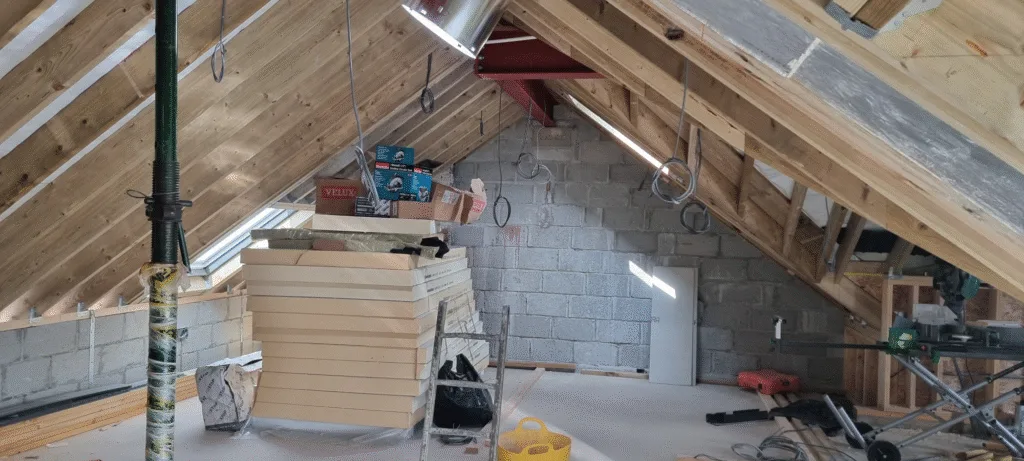First fix electrical installation underway for a new build property in Truro, establishing the electrical infrastructure during the construction phase.

Working on new build properties presents a different set of opportunities compared to rewiring existing homes. There’s something satisfying about installing electrical systems from scratch, where every cable run and circuit can be positioned exactly where it needs to be without the constraints of existing walls and structures.
We’re currently carrying out the first fix electrical work on a new build project in Truro. At this stage, the property is very much a building site, with exposed timber frames and studwork walls providing clear access to install all the necessary cabling and infrastructure. The timing of electrical work on new builds is quite specific – it has to happen after the structure is up but before the walls are closed in and plastered.
The first fix stage involves running all the cables throughout the property, setting up the routes that will eventually feed power and lighting to every room. In a new build, you’re working closely with the overall construction schedule, coordinating with other trades and making sure everything’s installed at the right time. Leave it too late and you’ll be fighting against finished walls; go too early and the building isn’t ready for you.
For this property, we’re installing the main consumer unit and meter position, establishing the heart of the electrical system. From there, cables are being run throughout the building, threading through timber frames in the walls and floor voids. Each cable is carefully routed to avoid potential clashes with plumbing or structural elements, following the building plans and regulations. The loft space requires particular attention, with cables being secured properly to meet current standards while leaving enough slack for the second fix stage.
New build electrics typically use modern wiring methods and materials throughout. The cable runs are being protected where necessary and fixed securely to prevent any movement or damage as the construction continues around them. Every circuit is planned to provide adequate capacity for the property’s needs, with separate circuits for lighting, sockets, and any specific requirements like cookers or showers.
One aspect of new build electrical work that differs from rewiring older properties is the complete freedom to position outlets, switches and light fittings in optimal locations. There’s no need to work around existing holes or make compromises based on previous installations. Everything can be placed according to the building plans and the most practical layout for how the space will actually be used.
The studwork walls provide straightforward access for running cables vertically and horizontally between rooms. Cables are being looped out ready for the second fix stage, when we’ll return to fit all the sockets, switches and light fittings once the walls are plastered and decorated. These loops need to be long enough to work with comfortably but not so excessive that they create problems behind the finished wall.
Floor void installations are another key part of this first fix. Running cables through floor joists requires drilling at the correct positions and angles to maintain structural integrity while creating clear cable runs. Each penetration through timber needs to be positioned according to building regulations, avoiding weak points and keeping cables away from where floor fixings might go later.
Working in a construction environment means adapting to the reality of a busy building site. Other trades are working simultaneously, materials are being delivered, and the property is changing every day. Good communication with the main contractor and other trades helps everything run smoothly and prevents any of that “I wish we’d known” feeling when something could’ve been done differently.
The loft space on this project presents typical challenges for new build electrical work. The roof structure is fully exposed, allowing us to secure cables properly and run them to where they need to go. Loft wiring needs extra care – cables must be protected from potential damage and installed in ways that account for future insulation and access needs. You’re thinking ahead to how the loft might be used years down the line, making sure nothing you do now creates problems later.
Circuit planning for new builds involves thinking about both immediate needs and future flexibility. Modern homes use more electrical power than ever before, with multiple devices in every room and increasing numbers of appliances. The electrical system needs sufficient capacity to handle current demands while allowing for future additions without needing immediate upgrades.
Building regulations for new build electrical work are comprehensive and specific. Every aspect of the installation must meet current standards, from cable sizes and protection to earthing arrangements and circuit design. These regulations exist for good reasons – they keep people safe and make sure electrical systems work reliably for decades. On new builds, everything’s inspected as part of the building control process, so there’s an extra layer of oversight beyond the usual electrical certification.
The meter position and consumer unit installation forms the main connection point for the property’s electrical supply. This needs to be accessible, protected, and positioned according to the utility company’s requirements as well as building regulations. Getting this right at the first fix stage prevents complications later when the power supply is actually connected.
Throughout the first fix stage, we’re marking cable runs and making detailed notes about what goes where. Once walls are closed in, knowing exactly where every cable runs becomes vital information. Good documentation at this stage makes the second fix much more straightforward and helps anyone who might work on the system in future.
New build electrical work represents a chance to install systems that will serve a property for many years. There’s a responsibility in that – doing thorough, careful work at the first fix stage creates a solid foundation for safe, reliable electrical systems. When walls are eventually finished and the property’s occupied, the electrical installation should be invisible but dependable, doing its job without fuss or problems.









Ready to make a difference? Explore exciting career opportunities with us!